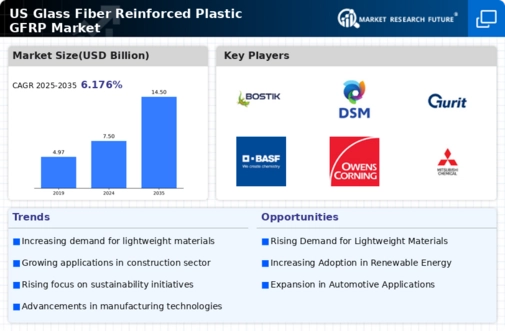The US Glass Fiber Reinforced Plastic (GFRP) Market has emerged as a notable segment within the composite materials industry, driven by its extensive applications across various sectors such as construction, automotive, and aerospace. Competitive insights within this market reveal a landscape characterized by innovation, collaboration, and strategic partnerships among key players aiming to capture market share. Companies are actively investing in research and development to enhance the properties of GFRP, such as its strength, durability, and resistance to corrosion.
Furthermore, with increasing environmental regulations, there is a growing emphasis on sustainable and eco-friendly production practices within the GFRP market, prompting manufacturers to adopt greener technologies. The competitive dynamics are also influenced by fluctuations in raw material prices, advancements in manufacturing processes, and varying demand patterns across different end-use industries.
Bostik
In examining the role of Bostik within the US Glass Fiber Reinforced Plastic GFRP Market, the company has established a strong presence through its commitment to providing high-quality adhesive solutions tailored for the composite materials sector. Bostik's advanced technologies in adhesives and sealants contribute significantly to enhancing the performance and longevity of GFRP applications, catering to various industries including automotive and construction. The company's focus on innovation allows it to stay ahead of competitors, demonstrating significant strengths in developing specialized formulations that improve bonding efficiency and resistance to environmental factors.
Bostik has effectively leveraged its expertise in adhesive technology to strengthen its position in the GFRP market, making it a vital player in meeting specific application needs across diverse sectors.
Royal DSM
Royal DSM holds a significant position in the US Glass Fiber Reinforced Plastic GFRP Market, well-known for its advanced composite solutions that encompass a range of key products and services. The company's portfolio includes high-performance materials designed to meet the rigorous demands of various applications, providing strength and durability needed in industrial settings. Royal DSM's commitment to sustainability and innovation is reflected in its continuous investment in research and development, enabling the creation of eco-friendly materials that align with modern environmental standards.
Additionally, the company has been active in mergers and acquisitions, enhancing its technological capabilities and expanding its market reach within the US. This strategic approach has enabled Royal DSM to strengthen its competitive advantage, positioning it as a leading force in the GFRP market, while seamlessly catering to the evolving needs of customers across industries.
























Leave a Comment